
The Isle of Man TT or Tourist Trophy races are an annual motorcycle racing event run on the Isle of Man in May/June of most years since its inaugural race in 1907. The event is often called one of the most dangerous racing events in the world as many competitors have died.

Stanley Michael Bailey Hailwood, was a British professional motorcycle racer and racing driver. He is regarded by many as one of the greatest racers of all time. He competed in the Grand Prix motorcycle world championships from 1958 to 1967 and in Formula One between 1963 and 1974. Hailwood was known as "Mike The Bike" because of his natural riding ability on motorcycles with a range of engine capacities.

The Triumph Trident and BSA Rocket 3 was a technically advanced, high-performance roadster motorcycle made by Triumph Engineering and BSA from 1968 to 1975, and sold under both the Triumph and BSA marques. Alongside the Honda CB750, and later the Kawasaki triples, it brought a new level of sophistication to street motorcycles, marking the beginning of the superbike era. The Honda CB750 overshadowed the Trident to be remembered as the 'first superbike', in spite of the Triumph Trident actually debuting before the Honda by a few weeks.

Associated Motor Cycles (AMC) was a British motorcycle manufacturer founded by the Collier brothers as a parent company for the Matchless and AJS motorcycle companies. It later absorbed Francis-Barnett, James, and Norton before incorporation into Norton-Villiers. Henry Herbert Collier founded Matchless as a cycle company in 1878. His sons Henry (Harry) and Charles (Charlie) joined him and the name was changed to H. Collier & Sons.

The BSA Gold Star is a motorcycle made by BSA from 1938 to 1963. They were 350 cc and 500 cc single-cylinder four-stroke production motorcycles known for being among the fastest bikes of the 1950s. Being hand built and with many optional performance modifications available, each motorcycle came from the factory with documented dynamometer test results, allowing the new owner to see the horsepower (bhp) produced.
The 1957 Isle of Man Tourist Trophy was the Golden Jubilee event and the second race in the 1957 Motorcycle World Championships.

Malcolm Ernest Uphill was a Welsh professional motorcycle racer. He competed in British national-level short-circuit and in Grand Prix motorcycle racing. Uphill was the first competitor in the Isle of Man Tourist Trophy races to achieve a 100 mph average lap speed on a production motorcycle.

The featherbed frame was a motorcycle frame invented by the McCandless brothers and offered to the British Norton motorcycle company to improve the performance of their racing motorcycles in 1950. It was considered revolutionary at the time, and the best handling frame that a racer could have. Later adopted for Norton production motorcycles, it was also widely used by builders of custom hybrids such as the Triton, becoming legendary and remaining influential to this day.
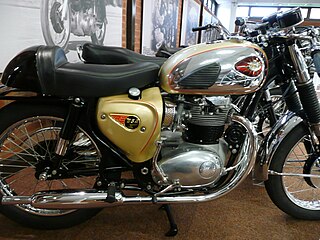
The BSA Lightning Clubman was a 650cc British motorcycle made by BSA at their factory in Birmingham between 1964 and 1965. Finished in gold and black the Lightning Clubman is now a highly sought after classic motorcycle. Due to the very limited production numbers replicas are created by enthusiasts from the BSA Lightning.
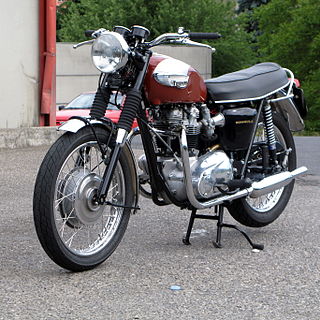
The Triumph Bonneville T120 is a motorcycle originally made by Triumph Engineering from 1959 to 1975. It was the first model of the Bonneville series, which was continued by Triumph Motorcycles Ltd. The T120 was discontinued in favour of the larger 750 cc T140 in the early 1970s.

The Dunstall Norton was a Norton motorcycle made by Paul Dunstall, a specialist tuner of the 1960s and early 1970s twins originally using some parts from Norton's Domiracer project when the Birmingham factory was closed in 1963. In 1966 Dunstall Motorcycles became a motorcycle manufacturer in its own right so that Dunstalls could compete in production races, and set a number of world records before sales of the Dunstall Nortons declined in the 1970s consistent with the demise of the British motor cycle industry and a corresponding rise in Japanese imports.
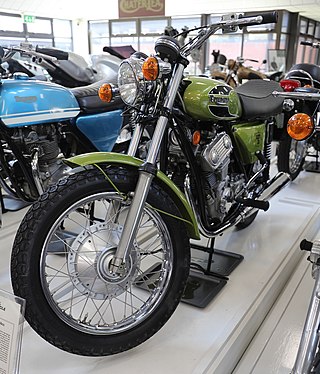
The Triumph Bandit was a British motorcycle manufactured as a prototype by Triumph in 1970. Originally designed by Edward Turner as his last project it was subsequently substantially modified at Triumph by a greatly critical Bert Hopwood and Doug Hele. Despite their work, the Bandit never went into commercial production, and only five have survived, making them very rare.

The following outline is provided as an overview of motorcycles and motorcycling:
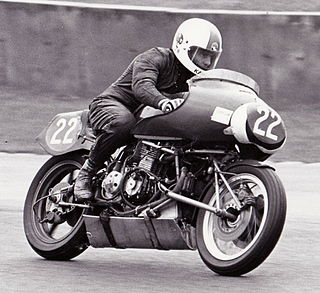
Mead & Tomkinson was a motorcycle and car dealership in Hereford and Tewkesbury, Gloucester, England. Three of the Tomkinsons, sons Chris and Patrick, and their father, Mike, successfully built and fielded racing motorcycles. They concentrated on the Isle of Man TT and on 24-hour and 8-hour endurance races at Spa, Barcelona, Thruxton and the Le Mans Bol d'Or. One of their riders was Neil Tuxworth.

2012 Manx Grand Prix Festival and Races were held between Saturday 18 August and Friday 31 August 2012 on the 37.73-mile Snaefell Mountain Course.

BSA motorcycles were made by the Birmingham Small Arms Company Limited (BSA), which was a major British industrial combine, a group of businesses manufacturing military and sporting firearms; bicycles; motorcycles; cars; buses and bodies; steel; iron castings; hand, power, and machine tools; coal cleaning and handling plants; sintered metals; and hard chrome process.
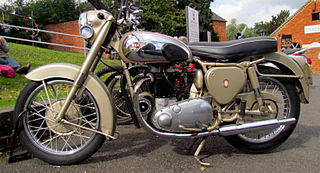
The BSA A10 series was a range of 646 cc (39.4 cu in) air-cooled parallel twin motorcycles designed by Bert Hopwood and produced by Birmingham Small Arms Company at Small Heath, Birmingham from 1950 to 1963. The series was succeeded by the A65 unit construction models.

The Yamaha TZ750 is a series production two-stroke race motorcycle built by Yamaha to compete in the Formula 750 class in the 1970s. Motorcyclist called it "the most notorious and successful roadracing motorcycle of the 1970s". Another journal called it the dominant motorcycle of the era, noting its nine consecutive Daytona 200 wins, starting in 1974.
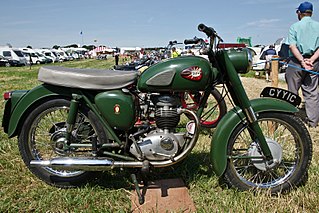
The BSA B40 was a series of 350 cc (21 cu in) unit construction single-cylinder OHV four-stroke motorcycles made by the Birmingham Small Arms Company. Developed from the BSA C15, the machines were produced between 1961 and 1967 for civilian use. Military versions were manufactured from 1967 to 1970. Around 14,000 machines were built in total.
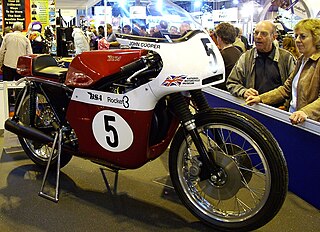
The BSA/Triumph racing triples were three cylinder 750 cc racing motorcycles manufactured by BSA/Triumph and raced with factory support from 1969-1974. There were road racing, production racing, endurance racing and flat track variants. The machines were based on the road-going BSA Rocket 3/Triumph Trident.



















